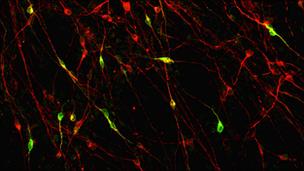Parkinson's artificial brain bank
- Published

Brain cells grown from the skin cells of a Parkinson's patient are likely to deteriorate
Researchers in Oxford have begun creating a bank of artificially grown brain cells from Parkinson's patients, BBC news has learned.
They are using a new stem cell technique that allows them to turn a small piece of skin from the patient into a small piece of brain.
This is the first time this has been done in a large-scale study aimed at finding cures for the disease.
Researchers say they can analyse nerve cells as they start to deteriorate.
The first batch of nerve cells have been grown from a 56-year-old Oxfordshire man, Derek Underwood.
He had to take early retirement because of the progression of the disease.
Mr Underwood will be the first of 50 patients whose skin cells will be grown into brain cells as part of a five year study.
According Dr Richard Wade Martins of Oxford University, who is leading the study, the aim is to build up a "brain bank" which will enable researchers to study how the disease develops in unprecedented detail.
"The brain is an inaccessible organ and you can't get bits of people's brain to study very easily," he said.
"But what we have here is a disease in a dish, that are just like Derek's brain cells but are accessible and can be produced in unlimited quantities"
Lab brain
The first step, according to Dr Michelle Hu of the John Radcliffe Hospital in Oxford, is to compare the brain cells grown from Parkinson's patients, with those grown from healthy volunteers and see how they differ.
"For the first time we can look at the cells before they deteriorate and look at the earliest changes," she said.
"We can look at what cellular processes are happening that make the cells die and learn why it is that the cells get sick. And we want to see if there are any treatments we can offer to reverse that process and help patients regain normal function."
This is the first large scale clinical study to use a technique which was developed by Japanese scientists three years ago, called "induced pluripotent stem cell" or IPS for short.
Genes are inserted into the skin cells, reprogramming them to become something else.
IPS is similar to the embryonic stem cell technique which was used to create Dolly the Sheep, but IPS does not result in the creation of an embryo and so is regarded by some as an ethically more acceptable approach.
- Published26 May 2011
- Published14 July 2010